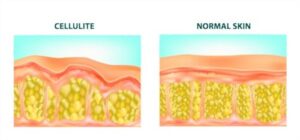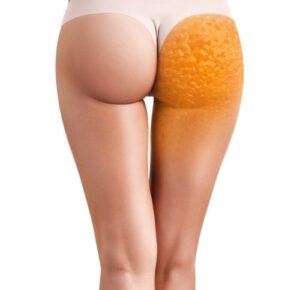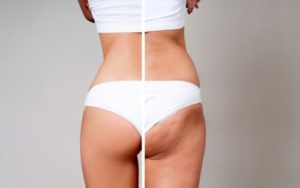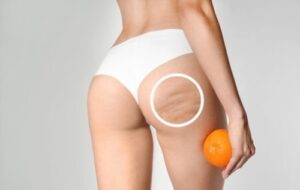If you are suffering from cellulite, don’t despair, you are not alone! It is estimated that between 80 – 90% of women will experience some kind of cellulite in their lifetime. Cellulite most commonly affects the thighs and buttocks, although it can also affect other areas, for instance the breasts, lower abdomen and upper arms.
 Whilst cellulite, also known as orange-peel skin due to its dimpled texture, can affect both men and women, it is more prevalent in women, most likely because of the difference of structure and distribution of muscle, fat and connective tissue between the two sexes.
Whilst cellulite, also known as orange-peel skin due to its dimpled texture, can affect both men and women, it is more prevalent in women, most likely because of the difference of structure and distribution of muscle, fat and connective tissue between the two sexes.
The exact cause of cellulite is not known, but it is widely speculated to be caused by an interaction between the connective tissue, under the surface of the skin in the dermatological layer, and the layer of fat beneath it. To put it more simply, it is the protrusion of fat into the connective tissue and skin which creates the uneven appearance of cellulite. In women the connective tissue and fat are arranged vertically, whilst in men they are crisscrossed, which possibly explains why the fat finds it easier to protrude in women and is more visible.
So what can we do to prevent cellulite? Unfortunately there are no hard or fast ways on how to avoid it. It is not predisposed to people who are overweight, as the fittest and most toned, or even an underweight body can have cellulite, although it is unlikely to be as pronounced and obvious.  Everyone, except for the severely malnourished, has at least a small layer of fat below the surface of the skin and it is the way this fat interacts which causes the appearance of cellulite.
Everyone, except for the severely malnourished, has at least a small layer of fat below the surface of the skin and it is the way this fat interacts which causes the appearance of cellulite.
Ultimately, it would seem that hormones also play a key role in cellulite development, and it is believed that cellulite may be more prevalent in women as they approach the menopause. This is due to the fact that the blood flow to the connective tissue decreases, thus circulating less oxygen, resulting in even lower collagen production and subsequently leads to weakened connective tissue. The loss of elasticity and thickness of the skin also makes it more penetrable by the fat cells.
Cellulite is also predisposed by genetics – metabolism speed, circulatory levels, ethnicity (which dictates the color and thickness of skin), and distribution of fat under the skin all play a role. It should be noted that contrary to some beliefs, cellulite is not related to a build-up of toxins, although this can exaggerate its appearance.
In summary, the answer to the question – what can we do to avoid cellulite? – absolutely nothing! However, diet, exercise and reducing toxins can help to avoid it being so visible. Generally people with a high fat, high carbohydrate and low fiber diet, a sedentary job and lifestyle, and therefore little or no exercise, will most likely accumulate more cellulite.
 There are several techniques to remove cellulite, ranging from laser treatments and acoustic wave treatment to more evasive treatments like subcision and tissue release cuts. The problem is that none of these are permanent. The cellulite can and will return if you are predisposed to it. Cellulite is not dangerous and has no health risk attached to it. However some people do feel totally self-conscious about it.
There are several techniques to remove cellulite, ranging from laser treatments and acoustic wave treatment to more evasive treatments like subcision and tissue release cuts. The problem is that none of these are permanent. The cellulite can and will return if you are predisposed to it. Cellulite is not dangerous and has no health risk attached to it. However some people do feel totally self-conscious about it.
Whilst you can’t put a price on your confidence, remember that you are not alone and that even the photos of those perfect models are air-brushed, so why spend huge amounts of money and possibly undertake evasive procedures for a short-term fix? There are many anti-cellulite creams available, all promising the impossible, but with their chemical ingredients all adding more toxins to your system, they are possibly exacerbating the problem long-term.
Meanwhile, aromatherapy has gained a reputation for its success in helping to break down or reduce the appearance of cellulite. A study took place in 2017 to examine the effectiveness of essential oils on cellulite and reported: “Collectively, botanical formulations applied topically as anti-cellulite intend to reduce lipogenesis, activate lipolysis, restore subcutaneous tissue normal structure, reduce free radical generation or scavenge free radicals, prevent inflammation, increase microcirculation, and lymphatic drainage.”
In other words, these 100% natural oils without chemical fortification work! So what are the recommendations for cellulite? Here is our pick:
Firstly we need to choose a carrier oil since most essential oils are highly potent and can irritate or even burn the skin, and therefore need to be diluted. A carrier oil will “carry’ the therapeutic properties into the skin and prevent the oil from evaporating too quickly. Whilst jojoba oil, Aloe Vera, coconut oil and sweet almond oil all have outstanding properties to assist in combatting the appearance of cellulite and would do a great job, the pick of the crop has to be.
Grape Seed Oil
This oil is rich in vitamins C, D and E, polyphenols and linoleic acid and is easily absorbed into the skin. Potent antioxidants help to reduce the signs of ageing, promote collagen and restore elasticity. It will help to buff away impurities and smooth and tone the skin, making the skin look visibly less saggy and lumpy. An excellent deterrent to cellulite in its own right.
Add a few drops of one of the following essential oils to maximize the effect, or make your own unique massage blend using a combination of oils:
 Grapefruit (Citrus paradisi)
Grapefruit (Citrus paradisi)
Grapefruit essential oil with its citrusy and refreshing aroma is deep cleansing and has detoxifying, slimming, anti-inflammatory and circulation boosting properties. By transporting toxins and impurities away from the skin it promotes healthy lymphatic drainage, encouraging healthy skin, preventing water retention, and reducing the look of cellulite over time.
An animal research study published in 2010 demonstrated that the bioactive compounds found in grapefruit are able to inhibit adipogenesis (the formation of fat or fatty tissue) which can also help to reduce the formation of cellulite.
Please note that this oil is phototoxic, so avoid direct sun for 24 hours after use.
Rosemary (Rosmarinus officinalis)
A refreshing woody and evergreen scent, rosemary essential oil has strong anti-inflammatory, antioxidant, stimulating, energizing and circulation boosting properties and can help to reduce puffiness, and encourage cell growth. It contains carnosol and carnosic acid which inhibit adipogenesis (the formation of fat or fatty tissue).
A study published in 2017 confirmed that rosemary oil is able to boost microcirculation and decrease cellular fat accumulation, stating that in the correct ratio it can “impact the multiple pathways involved in cellulite onset, continuation, or exacerbations.” A further clinical study in the Journal of Clinical and Aesthetic Dermatology also indicated that rosemary essential oil is a powerful weapon against cellulite, citing that it had reduced the appearance of cellulite by 52.9%, whilst improving skin firmness and elasticity by 57.9%.
 Fennel (Foeniculum dulce)
Fennel (Foeniculum dulce)
Aniseed scented fennel has traditionally been used to help against the appearance of cellulite. It is a natural exfoliator with antioxidant, anti-inflammatory and diuretic properties. It can help to dispel fats and toxins from the tissue and reduce the appearance of cellulite worsened by this buildup.
Fennel has a toning and lifting effect on the skin, helping to smooth out imperfections, whilst stimulating the production of collagen, and strengthening the epidermis. Fennel oil can help to balance the hormones and is particularly helpful to women whose cellulite has been exacerbated by the onset of the menopause.
Lemon (Citrus limon)
Lemon has a citrusy and energizing aroma, is a particularly good aid for skin exfoliation, and has long been used as a cellulite treatment. It has potent antioxidant, anti-inflammatory, skin-protective, slimming and cleansing properties. This oil improves circulation in the area where it is applied, thus strengthening tissues and helping to keep fat intact under the dermis.
Lemon oil is a natural fat dissolver and encourages the breakup of fatty deposits beneath the skin. Additionally, lemon oil can help to stimulate lymphatic drainage, cleanse toxins from the body and help to purify the skin. The overall result is refreshed, smooth and even skin, with a reduction in the dimply appearance of cellulite.
Please note that this oil is phototoxic, so avoid direct sun for 24 hours after use.
Orange (Citrus sinensis)
It is perhaps poetic justice that the oil obtained from orange peel has huge benefits as an anti-cellulite treatment, when cellulite itself is often referred to as “orange peel” skin. Orange oil has antioxidant, anti-inflammatory, circulation boosting and diuretic properties.
Orange oil has antioxidant, anti-inflammatory, circulation boosting and diuretic properties.
As a collagen promoter it can help to strengthen connective tissues, thus fighting the dimpling effect. Orange essential oil stimulates blood circulation and lymphatic drainage, and as a fat-burner helps to dissolve fatty plaques. This oil will leave the areas of cellulite looking firmer, smoother, and more toned.
Please note that this oil is phototoxic, so avoid direct sun for 24 hours after use.
How to use: Mix 5-6 drops of the chosen essential oil/oils with 4 tsp (20 ml) of a carrier oil such as grape seed oil. Apply generously onto the cellulite-affected regions and massage thoroughly, 3-4 times a week.
 Remember that there is no quick overnight fix. Regular massage of the affected area is required, but the end result will be well worth the effort. It would also be beneficial to incorporate dry-brushing into the cellulite skin-care regime to further exfoliate and stimulate the skin, and reduce the buildup of toxins.
Remember that there is no quick overnight fix. Regular massage of the affected area is required, but the end result will be well worth the effort. It would also be beneficial to incorporate dry-brushing into the cellulite skin-care regime to further exfoliate and stimulate the skin, and reduce the buildup of toxins.
Since cellulite cannot be completely eliminated, massage will need to be continued, once or twice a week, as a preventative measure.
